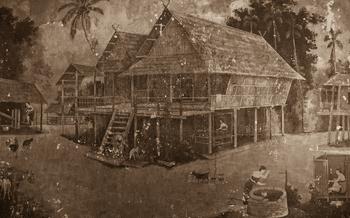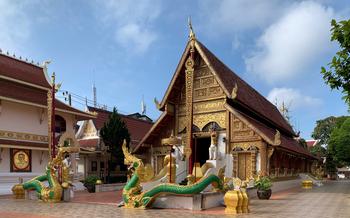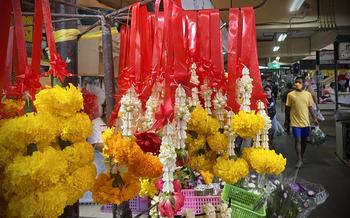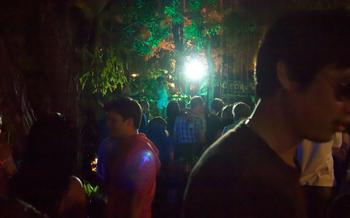
Ko Phayam Temple
- The Main Shrine
- The Bell Tower: A Symbol of Time and Harmony
- The Assembly Hall
- The Buddha Image Garden
- Monk's Quarters
- Temple Festivals and Events
- Local Legends and Myths
- The Temple's Role in the Community
- Volunteer Opportunities
- Respecting Temple Etiquette
- Tips for Photography
- Nearby Attractions:
- Insider Tip: Unveiling the Secret Garden and its Mystical Charm
The Main Shrine
At the heart of the Ko Phayam Temple lies the majestic main shrine, a testament to the intricate artistry and deep devotion of the local community. This awe-inspiring structure commands attention with its graceful curves, intricate carvings, and vibrant hues. The main shrine houses the most sacred relics and Buddha images, which are revered by devotees from far and wide.
Within the sanctum of the main shrine, visitors will find a resplendent array of Buddha images, each exuding a unique aura of serenity and compassion. Devotees offer prayers, light incense, and make offerings to these sacred figures, seeking blessings and guidance in their daily lives. The air hangs heavy with the scent of jasmine and marigold garlands, creating an atmosphere of spiritual devotion.
Rituals and ceremonies are meticulously performed within the main shrine, adhering to ancient Buddhist traditions. Devotees chant mantras, offer food and flowers, and engage in meditation, seeking inner peace and enlightenment. The main shrine serves as the focal point for religious observances and is considered the most sacred space in the entire temple complex.
The Bell Tower: A Symbol of Time and Harmony
The bell tower, a prominent feature of the Ko Phayam Temple, stands tall and majestic, symbolizing the passage of time and the harmony of the Buddhist faith. Its intricate design and architectural details reflect the craftsmanship and devotion of the temple's builders.
The bell tower is a multi-tiered structure, each level adorned with intricate carvings and motifs that narrate stories from Buddhist mythology. The tower's base is wide and sturdy, providing a solid foundation for the structure above. As the tower rises, it tapers gracefully, creating a sense of lightness and elegance.
At the top of the bell tower hangs a large bronze bell, its surface adorned with auspicious symbols and inscriptions. The bell is suspended by a sturdy rope, allowing it to be rung by devotees during ceremonies and rituals.
The sound of the bell is both powerful and melodious, reverberating through the temple grounds and beyond. It serves as a reminder of the Buddha's teachings, calling the faithful to prayer and meditation. In the Buddhist tradition, the bell's ringing is believed to dispel negative energy, bring good fortune, and promote peace and harmony.
During temple festivals and special occasions, the bell is rung continuously, creating a festive atmosphere and drawing the attention of the community. It is a symbol of unity and celebration, bringing people together to share in the joy and blessings of the temple.
In the daily life of the temple, the bell plays a crucial role in marking the passage of time. It is rung at dawn to signal the start of the day, at noon to remind the monks of their midday meal, and at dusk to mark the end of the day's activities.
The bell tower, with its majestic presence and symbolic significance, is an integral part of the Ko Phayam Temple, representing the harmonious blend of time, spirituality, and community.
The Assembly Hall
The assembly hall, also known as the vihara, is a vital part of the Ko Phayam Temple complex. It serves as a communal space for monks and laypeople to gather for various religious activities, meetings, and social events. The assembly hall is typically a spacious and well-ventilated building, designed to accommodate a large number of people.
The architectural features of the assembly hall reflect traditional Thai temple design. The roof is often adorned with intricate carvings and colorful tiles, while the walls are decorated with murals depicting scenes from Buddhist mythology and history. The interior of the hall is dominated by a large Buddha image, which is placed on a raised platform and surrounded by smaller Buddha images and offerings.
The assembly hall is used for a variety of purposes, including daily prayers, meditation sessions, and chanting. It is also the venue for special ceremonies and events, such as ordination ceremonies, merit-making ceremonies, and temple festivals. During these events, the assembly hall is transformed into a vibrant and lively space, filled with the sounds of chanting, music, and the laughter of community members.
The assembly hall plays a crucial role in the daily life of the temple community. It is a place where monks and laypeople come together to share their faith, learn from each other, and strengthen their bonds as a community. It is also a place where visitors can come to learn more about Buddhism and experience the vibrant spiritual life of the temple.
The Buddha Image Garden
Tucked amidst the lush greenery of the temple grounds lies the serene Buddha Image Garden, a sanctuary of peace and spiritual contemplation. As you step into the garden, you are greeted by a tranquil atmosphere, where rows of Buddha images of various sizes and postures adorn the serene landscape. Each Buddha image exudes a unique aura, inviting visitors to pause and reflect on the teachings of the Buddha.
The garden is meticulously landscaped, with pathways winding through the serene rows of Buddha images. The images are arranged in a harmonious pattern, creating a sense of order and balance. Some Buddha images are seated in the lotus position, symbolizing meditation and inner peace, while others stand tall, representing strength and determination. Visitors can spend hours wandering through the garden, admiring the intricate details of each image and contemplating their profound meanings.
The Buddha Image Garden is not only a place of worship but also a sanctuary for meditation and self-reflection. Devotees often come to the garden to offer prayers, light incense, and make offerings to the Buddha images. The tranquil ambiance of the garden provides an ideal setting for visitors to connect with their inner selves and seek spiritual guidance.
As you stroll through the garden, you may notice that some Buddha images have been adorned with colorful robes, flowers, and other offerings. These offerings are a symbol of devotion and respect, and they add a vibrant touch to the serene landscape. The garden is a living testament to the deep faith and reverence that the local community has for the Buddha and his teachings.
Whether you are a devout Buddhist or simply seeking a place of tranquility, the Buddha Image Garden at Ko Phayam Temple is a must-visit destination. It is a place where you can find peace, inspiration, and a deeper connection to your spiritual self.
Monk's Quarters
The monk's quarters, also known as the vihara, is an essential part of the Ko Phayam Temple complex. It is where the monks reside and conduct their daily activities. The quarters typically consist of a series of simple, wooden or brick buildings arranged around a central courtyard. Each monk has his own room, which is usually small and sparsely furnished with a bed, a desk, and a few personal belongings.
The daily routine of the monks begins early in the morning with meditation and chanting. They then go out to collect alms from the local community, which is a traditional practice in Theravada Buddhism. After their morning alms round, the monks return to the temple to eat breakfast and study the Buddhist scriptures. The rest of the day is spent in meditation, prayer, and other religious activities.
The monk's quarters are not usually open to the public, but visitors may be able to catch a glimpse of the monks going about their daily lives. It is important to be respectful and not disturb the monks while they are meditating or praying.
Temple Festivals and Events
The Ko Phayam Temple is a vibrant center of religious and cultural celebrations throughout the year. The temple's festivals and events are a testament to the deep-rooted Buddhist traditions and the strong sense of community that exists in the area.
One of the most significant events celebrated at the temple is the annual Visakha Bucha Day, which commemorates the birth, enlightenment, and passing of Lord Buddha. During this festival, the temple is adorned with colorful decorations, and special ceremonies and rituals are held to honor the Buddha's teachings. Devotees from neighboring villages and towns flock to the temple to participate in these festivities, which include chanting, meditation, and the offering of alms to the monks.
Another important festival celebrated at the temple is the Songkran Festival, also known as the Thai New Year. During Songkran, the temple becomes a hub of activity as locals and visitors alike come together to celebrate the new year. Water-throwing ceremonies are a highlight of the festival, symbolizing the washing away of bad luck and the cleansing of the spirit.
In addition to these major festivals, the temple also hosts regular events such as merit-making ceremonies, where devotees offer food and other necessities to the monks, and Dhamma talks, where monks share their wisdom and teachings with the community. These events provide an opportunity for the local community to come together, strengthen their faith, and deepen their understanding of Buddhism.
Local Legends and Myths
The Ko Phayam Temple is steeped in local legends and myths that have been passed down through generations, shaping the cultural identity of the community. One popular legend tells the story of a group of fishermen who were caught in a fierce storm while out at sea. In their desperation, they prayed to the Buddha for protection, promising to build a temple in his honor if they were saved. Miraculously, the storm subsided, and the fishermen returned to shore safely. True to their word, they constructed the Ko Phayam Temple as a testament to their gratitude and devotion.
Another legend associated with the temple revolves around a sacred bell that is said to possess magical powers. According to the tale, the bell was cast using a special alloy that was blessed by a revered monk. The sound of the bell is believed to bring good fortune, ward off evil spirits, and promote harmony within the community. Devotees often ring the bell before entering the temple to purify themselves and seek blessings.
These legends and myths are an integral part of the temple's history and heritage. They add a layer of enchantment and mystique to the site, making it a place of both religious and cultural significance. Visitors to the Ko Phayam Temple can immerse themselves in these stories and gain a deeper understanding of the local beliefs and traditions that have shaped the temple's existence.
The Temple's Role in the Community
The Ko Phayam Temple plays a significant role in the local community, extending its influence beyond religious practices. It serves as a center for social and welfare activities, contributing to the well-being and development of the community. The temple actively engages in various initiatives to support its members and the surrounding area.
One of the key roles of the temple is providing education and healthcare services. It runs educational programs for children and adults, offering classes in religious studies, language, and vocational skills. The temple also operates a clinic that offers free medical care to those in need, regardless of their religious affiliation.
Additionally, the temple actively participates in community development projects. It collaborates with local organizations and initiatives to improve infrastructure, promote sustainable practices, and address social issues. The temple's involvement in these projects demonstrates its commitment to the overall well-being and progress of the community.
Furthermore, the temple serves as a center for community gatherings and events. It hosts festivals, celebrations, and meetings, bringing people together to strengthen social bonds and foster a sense of community. These events provide opportunities for cultural exchange, entertainment, and the preservation of local traditions.
The temple's role in the community extends beyond religious activities, encompassing social welfare, education, healthcare, and community development. Its commitment to serving the community reflects its deep connection with the people and its dedication to their well-being and progress.
Volunteer Opportunities
Visitors to the Ko Phayam Temple have the opportunity to volunteer and contribute to the temple's activities, gaining a unique and fulfilling experience. Various volunteer programs and projects are available, catering to individuals with diverse skill sets and interests.
Whether assisting with temple maintenance, teaching English to local children, or participating in community development initiatives, volunteers play a vital role in supporting the temple and the surrounding community.
Volunteering at the temple offers visitors a chance to immerse themselves in the local culture, connect with the monks and residents, and make a meaningful impact. It's an enriching experience that fosters cross-cultural understanding, promotes compassion, and leaves a lasting positive impression on both the volunteers and the community they serve.
By contributing their time and skills, volunteers not only support the temple's ongoing operations but also gain a deeper appreciation for Buddhist traditions and Thai culture. The experience fosters a sense of community and encourages visitors to become active participants in preserving and promoting the temple's rich heritage.
Respecting Temple Etiquette
When visiting the Ko Phayam Temple, it is essential to observe proper etiquette to show respect for the sacredness of the site and the local culture. Here are some guidelines for respectful behavior:
-
Dress appropriately: Visitors should dress modestly and respectfully when entering the temple grounds. Avoid wearing revealing or overly casual clothing. For men, it is recommended to wear long pants and a collared shirt, while women should wear a long skirt or pants with a blouse or shirt that covers their shoulders.
-
Remove your shoes: Before entering the temple, remove your shoes and leave them outside. This is a common practice in Buddhist temples to show respect for the sacred space.
-
Be mindful of your body language: When inside the temple, be mindful of your body language and gestures. Avoid pointing your feet towards Buddha images or other sacred objects, as this is considered disrespectful.
-
Speak softly and respectfully: Keep your voice down and avoid loud conversations or laughter while inside the temple. Be respectful of the peace and tranquility of the sacred space.
-
Refrain from touching Buddha images: It is considered disrespectful to touch Buddha images or other sacred objects without permission. If you wish to make an offering, place it at the designated spot without touching the image itself.
-
Ask permission before taking photos: Before taking photos or videos inside the temple, ask permission from the monks or temple staff. Be mindful of the privacy of others and avoid taking photos of people without their consent.
By following these guidelines, you can show respect for the Ko Phayam Temple and contribute to preserving its sacred atmosphere for future generations.
Tips for Photography
When visiting the Ko Phayam Temple, it is important to be mindful of the sacred nature of the site and to respect the privacy of the monks and other visitors. Photography is allowed within the temple complex, but it is essential to follow ethical guidelines and proper etiquette.
-
Respectful Approach: Always ask permission before taking photos of monks or other individuals. Be considerate of their wishes and avoid capturing them in unflattering or disrespectful poses.
-
Appropriate Attire: Dress modestly and appropriately when visiting the temple. Avoid wearing shorts, tank tops, or revealing clothing that may be considered disrespectful in a religious setting.
-
Composition and Angles: Pay attention to the composition and angles of your shots. Avoid taking photos that could be intrusive or disruptive to ongoing ceremonies or rituals.
-
Flash Photography: Flash photography is generally not allowed inside the temple buildings to preserve the integrity of the artifacts and paintings.
-
Cultural Appreciation: Use photography as a means of cultural appreciation and understanding. Capture the beauty and essence of the temple, its architecture, and the daily life of the monks.
-
Privacy and Consent: Be mindful of the privacy of other visitors. Avoid taking photos that could be intrusive or embarrassing to individuals without their consent.
By following these guidelines, you can ensure that your photography at the Ko Phayam Temple is respectful, ethical, and contributes to a positive and enriching experience for all.
Nearby Attractions:
Beyond the spiritual and historical significance of the Ko Phayam Temple, the surrounding area offers a plethora of attractions that will captivate travelers seeking diverse experiences. The pristine beaches of Ko Phayam, just a short boat ride away, invite visitors to bask in the sun, swim in the crystal-clear waters, and indulge in water sports. Nature enthusiasts can embark on a jungle trek in the lush forests of Ranong, home to exotic wildlife and stunning waterfalls. For those seeking cultural immersion, the vibrant Ranong Night Market offers a tantalizing array of local delicacies and handmade crafts, providing a glimpse into the region's rich culinary and artistic traditions. The nearby hot springs of Bang Ron offer a unique opportunity to relax and rejuvenate in the natural thermal waters. Whether you seek adventure, relaxation, or cultural exploration, the vicinity of the Ko Phayam Temple promises an unforgettable journey.
Insider Tip: Unveiling the Secret Garden and its Mystical Charm
Venture beyond the main temple complex and discover a hidden gem—the Secret Garden. Nestled amidst lush greenery and serene surroundings, this enchanting garden is a sanctuary of tranquility and a place of spiritual connection. Adorned with beautiful flowers, aromatic herbs, and ancient trees, the garden exudes a mystical aura that invites contemplation and introspection.
As you wander through the Secret Garden, you'll encounter hidden nooks and secluded corners, each offering a unique perspective and a sense of serenity. Take a moment to sit beneath the shade of a Bodhi tree, where Buddha is said to have attained enlightenment, and let the peaceful atmosphere wash away your worries.
The Secret Garden is a place where nature and spirituality intertwine, creating a harmonious and sacred space. It is a sanctuary for reflection, meditation, and connecting with your inner self. Whether you're seeking solace, inspiration, or simply a moment of tranquility, the Secret Garden awaits your discovery.
Remember to respect the sanctity of this hidden treasure and maintain silence as you explore its enchanting paths. Embrace the opportunity to experience a deeper connection with the temple and its surroundings, leaving with a renewed sense of peace and tranquility.







